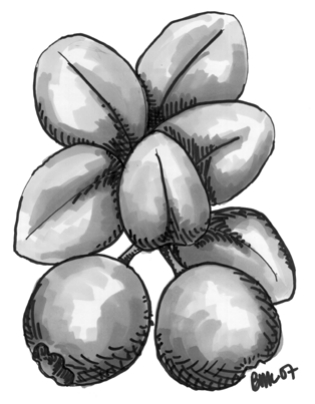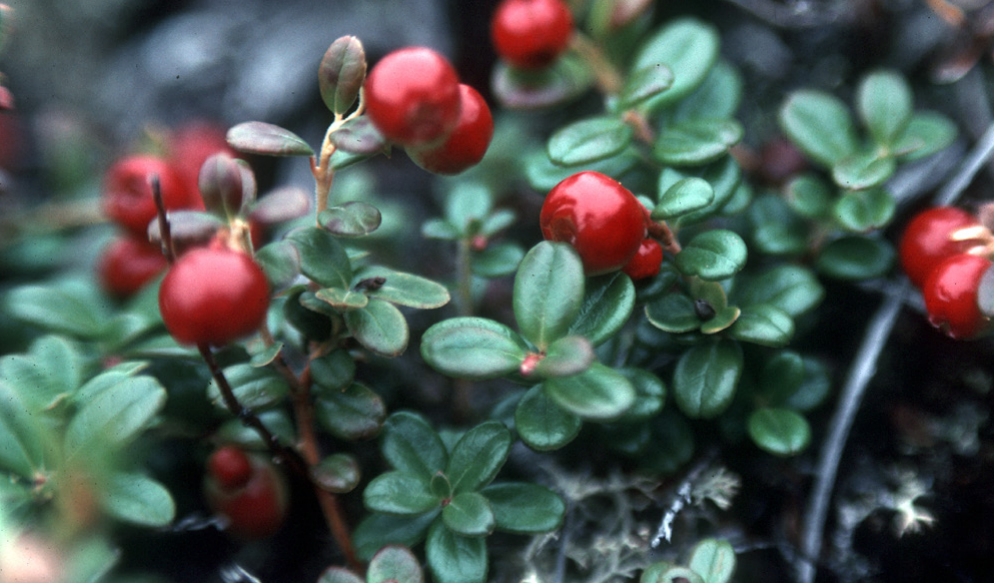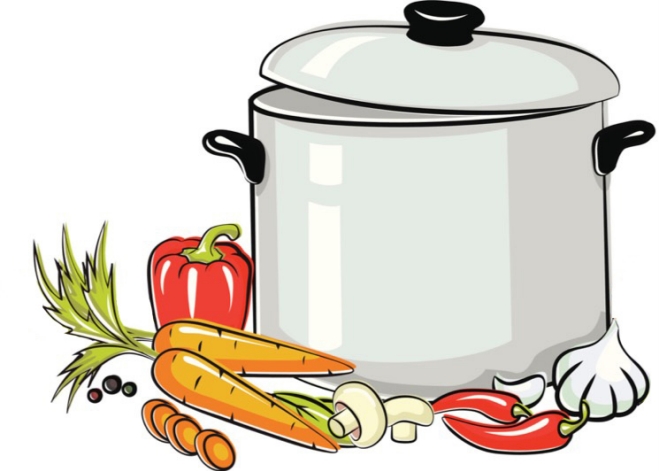Lowbush Cranberries or Lingonberries
FNH-00110 View this publication in PDF form to print or download.
Lingonberries, also called “lowbush cranberries,” are used extensively in food products
because they are easily preserved and have excellent flavor. Used as a  substitution in recipes for commercial cranberries, lingonberries have more flavor
and color. Because of their high acid content, all cranberries should be cooked in
glass, enamel, or stainless steel cookware.
substitution in recipes for commercial cranberries, lingonberries have more flavor
and color. Because of their high acid content, all cranberries should be cooked in
glass, enamel, or stainless steel cookware.
Nutrition and Health
Lingonberries are an excellent source of antioxidants. Antioxidants are a group of biochemicals shown to be an important part of the human diet partially due to their ability to affect the aging process.
Researchers use the oxygen radical absorption capacity test (ORAC) to measure levels of antioxidants in foods. Lingonberries scored a 203. Any score above 40 is considered very high.
When lingonberries are processed, antioxidant levels change, yet they are still high compared to other fruits.
Alaska lingonberry products provide the following ORAC values:
| Product | Score |
|---|---|
| Dried berries | 820 |
| Fruit leather | 550 |
| Frozen fruit | 160 |
| Frozen juice | 130 |
| Canned Juice | 120 |
| Canned Fruit | 99 |
| Jam | 36 |
| Syrup | 44 |
Selection, Cleaning and Storage
Lingonberries are usually available in the late fall and should be picked preferably after the first frost. The ripe fruit is deep red and similar in appearance to the commercial cranberry but much smaller. For best flavor, choose berries that are ripe and firm.
Spread a clean, dry terry cloth towel over a slanted surface, such as a cutting board. Prop up one end of the board a few inches above the other. Gently roll the berries down the towel; most of the debris and leaves will cling to the towel while the berries roll off. Lingonberries stored in a cool place will keep without further preservation.
Freezing
Lingonberries may be stored frozen. Prepare berries for freezing by removing any stems and sorting out soft berries. Use either of the two methods for freezing berries described below. Properly frozen berries will maintain good quality for up to two years.
Freezing method 1. Prepare berries as described. Choose firm berries with glossy skins. Wash, only if necessary, and drain before packaging into freezer containers. Seal, label and freeze.
Freezing method 2. Prepare berries as described. Arrange fresh dry berries in a single layer on a cookie sheet. Place the cookie sheet in the freezer. When frozen, transfer berries to freezer bags or containers. Seal, label and freeze.
Drying
Pretreat fruit – For best results pretreat lingonberries for drying. Select firm glossy berries and dip in boiling water to crack the skins. Without pretreatment, the berries remain puffy, very lightweight and drying time is increased.
Sun – Hot, dry, breezy days are best when drying fruits in the sun. A minimum temperature of 85 degrees F is needed with higher temperatures being better. Ideally, humidity should be below 60 percent. Pretreat berries. Cover a flat tray with cheesecloth or light muslin. Spread the berries on the cloth; place tray in the sun. Dry in sun for 2 days turning once or twice. Then set tray in a warm, dry place and let lingonberries stand until leathery to the touch.
Electric Oven – Pretreat berries. Use a very low heat (140 degrees F). The oven door must be left ajar so moisture can escape. Estimated drying time is 48 to 72 hours.
Dehydrator – Pretreat berries. Spread dry, clean berries on open screen. Follow instructions that come with the dehydrator. The optimum temperature for drying berries is 140 degrees F. Estimated drying time is 24 to 36 hours.
When properly dried, berries will be pliable and leather-like. Store dried, cooled berries in a clean airtight container. Place in an area that is cool, dark, and dry for four months to a year. Use as you would raisins. Dried lingonberries can be soaked in water for use in baking.
Extracting Juice
Combine 4 cups of cleaned lingonberries with 2½ cups water. Crush berries. Bring water to a simmer, cover and simmer for 10 minutes. Strain through a jelly bag or use a colander lined with several layers of cheesecloth. Let the juice drip into a bowl. For clear juice, do not twist or press jelly bag or cheesecloth. For long term storage, the juice should be canned or frozen.
Yield: 3 cups
Hot pack for juice
Sterilize canning jars. Heat juice, stirring occasionally, until it begins to boil. Pour into hot jars, leaving ¼ inch headspace. Wipe jar rims. Adjust lids. Process in a boiling water-bath canner.
- Quarts and smaller: 5 minutes
- Half gallons: 10 minutes
Preparing puree
Cooked Method – Add 1 cup water to 4 cups lingonberries. Cook until skins have popped. Press through a food mill or sieve. Discard skins and seeds.
Yield: 2 cups
Uncooked Method – Rinse 4 cups lingonberries, drain, put in a blender and blend until the consistency of thick puree.
Yield: 2 cups
To freeze, pack into rigid containers leaving ½ inch headspace for expansion. Seal and freeze.
To can, fill hot jars with hot puree, leaving ¼ inch headspace. Process quarts or pints in a boiling water bath for 15 minutes. Purees can be processed in a dial gauge pressure canner for 8 minutes at 6 pounds or at 5 pounds pressure in a weighted gauge canner.
Sweetened Puree – Sweeten puree to taste, about 2 cups sugar for each quart of puree. Use as an iced dessert or serve with poultry or meat.
- To sterilize canning jars, boil in water for 5 minutes.
- To prepare two-piece lids (rings and tops), wash, rinse set aside until ready to use. Follow manufacture’s directions for use.
- If less sugar is desired in recipes calling for pectin, be sure to use no-sugar-needed pectin and follow the instructions on the box.
- See later instructions on this page for how to use a boiling water canner.
Recipes
Spiced Lingonberry Juice
- 1 teaspoon whole allspice
- 2 sticks cinnamon (2 inches long)
- 12 whole cloves
- ⅔ cup brown sugar, packed
- 8 cups lingonberry juice
- Dash ground nutmeg
Tie allspice, cinnamon, and cloves together loosely in a cheesecloth bag. In a large saucepan combine lingonberry juice, and sugar; heat. Add spice bag; simmer 10 minutes or until juice is spicy enough to suit taste. Remove spice bag. Serve hot in mugs with a dash of nutmeg in each.
Yield: 8 cups
Lingonberry Applesauce Fruit Leather
- 2 cups lingonberry puree
- 2 cups unsweetened applesauce
- ¼ cup sugar (if using an artificial sweetener, sweeten to taste)
Combine lingonberry puree, applesauce and sugar. Line a cookie sheet with plastic wrap or use plastic leather tray in a dehydrator. Spread puree mixture evenly about ¹⁄8 to ¼ inch thick over the plastic or tray, but do not push it completely to the sides. Leave a bit of plastic showing for easy removal.
Oven dry at 140 degrees F for 10 to 18 hours, leaving oven door slightly open so moisture can escape. Test periodically for dryness. Leather dries from the outside edge toward the center. Test for dryness by touching the center of the leather; no indentation should be evident. Continue drying until leathery.
In a dehydrator, lightly oil the plastic leather tray or spread the puree on parchment paper cut to fit the dryer racks. Do not push the puree completely to the sides. Dry at 140 degrees F for six to eight hours until evenly dry and leathery. While warm, peel from plastic and roll; allow to cool and rewrap the roll in plastic. The leather will keep up to one month at room temperature. For storage up to one year, place tightly wrapped rolls in freezer.
Lingonberry Catsup
- 1 pound lingonberries
- ½ cup mild vinegar
- ½ cup water
- 1 cup brown sugar
- ½ teaspoon cloves
- ½ teaspoon ginger
- ½ teaspoon paprika
- 1 teaspoon cinnamon
- ¼ teaspoon pepper
- ½ teaspoon salt
- 2 tablespoons butter or margarine
Boil the berries in the vinegar and water until soft. Press through a sieve. Add the sugar, spices, and salt and cook slowly for 4 or 5 minutes. Add the butter. Pour into sterilized jars, wipe rims, adjust lids and process 5 minutes in a boiling water bath. Serve at room temperature with pork or poultry.
Lingonberry Banana Jam
- 3 cups lingonberries
- 1½ cups water
- 2 cups mashed bananas (about 4 bananas)
- 7 cups sugar
- 3 ounces liquid pectin
Wash jars and keep in hot water. Prepare lids and bands. Open liquid pectin pouch and stand upright in a cup or glass. Simmer the lingonberries and water for 10 minutes. Add the mashed bananas and sugar. Bring to a boil and boil hard for one minute. Remove from heat. Add the liquid pectin. Stir and quickly skim off foam. Immediately pour jam into hot one-pint or half-pint canning jars, leaving ¼ inch head space. Wipe jar rims and adjust two-piece lids. Process 15 minutes in a boiling water bath.
Yield: 7 cups.
Lingonberry Jelly
- 3 cups lingonberry juice
- 3 cups sugar
- 3 ounces liquid pectin
Sterilize pint or half-pint canning jars for 10 minutes in boiling water. Prepare lids and bands. Open pectin pouch and stand it upright in a cup or glass. Measure juice into a large saucepan. Stir in sugar. Place on high heat; stir constantly and bring to a full rolling boil that cannot be stirred down. Add the liquid pectin and heat again to a full rolling boil. Boil hard for 1 minute, stirring constantly. Remove from heat and quickly skim off foam. Immediately pour jelly into hot canning jars, leaving ¼ inch head space. Wipe jar rims and adjust two-piece lids. Process 5 minutes in a boiling water bath.
Yield: 3 cups
Lingonberry Sauce
- 4 cups lingonberries
- 3 cups sugar
- ½ cup water
Combine ingredients in a saucepan. Mix well. Bring to a rolling boil and cook until mixture gels, approximately 20 minutes. Chill before serving. Store in the refrigerator for no more than one month.
Yield: 5 cups
- Fill the canner halfway with water. Preheat water to a low boil. Place filled jars, fitted with lids, into the canner on the rack. Add more boiling water, if needed, so the water level is at least 1 inch above jar tops. Turn heat to its highest position until water boils vigorously. When the water boils, set a timer for the recommended processing time indicated in the recipe. Cover with the canner lid and lower heat setting to maintain a gentle boil throughout the processing time. Add more boiling water, if needed, to keep the water level above the jars.
- When the jars have been boiled for the recommended time, turn off the heat and remove the canner lid. Using a jar lifter, remove the jars and place them on a towel, leaving at least 1 inch of space between the jars during cooling.
- After cooling jars for 12 to 24 hours, remove the screw bands and test seals. Press the middle of the lid with a finger. If the lid springs up when finger is released, the lid is unsealed. If a lid fails to seal on a jar, remove the lid and check the jar-sealing surface for tiny nicks. If necessary, change the jar, add a new, properly prepared lid and reprocess within 24 hours using the same processing time. Alternately, adjust headspace to 1½ inches and freeze or store in the refrigerator and use within three days.
- If lids are tightly sealed on cooled jars, remove screw bands, wash the lid and jar
to remove food residue, then rinse and dry jars. Label and date the jars. Store
in a clean, cool, dark, dry place.

Sarah R-P. Lewis, Extension Faculty, Health, Home and Family Development. Originally written by Sonja Koukel, former Extension Faculty, Health, Home and Family Development
Revised November 2021
